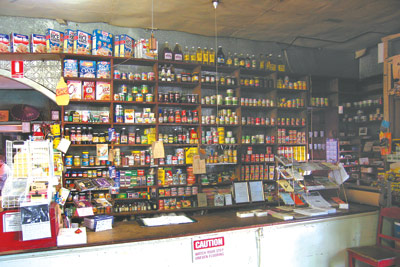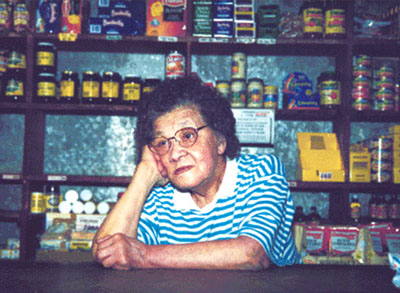Wing Hing Long 1930 To Present Day
Mavis Pratt in 1998. Photograph by Janis Wilton.
In 1939 Fong Quain and Marjorie died. Jack Joe moved to Tamworth with Mavis and Verdon to establish another shop called W.H. Long Ltd. Edgar and Ronald stayed in Tingha to run the family businesses. While in Tamworth, Mavis met and married John Pratt. In the late 1940s, the couple with their two sons, John and Peter, moved back to Tingha to take over the management of Wing Hing Long. By 1951, when Mavis purchased the store, the marriage had ended. The shop became a source of income for Mavis, who as a single parent ran the shop with the help of her two sons John and Peter through the 1950s and 1960s. They provided a phone order delivery service. Mavis continued to employ local residents to take phone orders, collect money, make deliveries and work in the shop. Further services were introduced such as the chemist shop and a lay-by section to the main showroom and the hardware sections. Mavis ran the shop single-handed from the late 1960s until her retirement in early 1998.
In the 1990s historian Janis Wilton identified the store's heritage significance while carrying out research for the Golden threads project. The store and its movable heritage collection are recognised as one of the most significant remaining examples of a Chinese - Australian rural general store. In early 1998, the store and its contents were purchased by Guyra Shire Council with financial assistance from the NSW Heritage Office and Arts NSW to be operated as a living museum and managed by local residents. The museum's purpose is to maintain its fabric and collections as much as possible as it was early in 1998 when the shop was closed for business.
The buildings, fittings and collection provide tangible evidence of the development of the store and a valuable resource to interpret its history throughout the twentieth century. In 2000 the Wing Hing Long & Co Store was listed on the State Heritage Register. A Conservation and Museum Management Plan was completed in August 2000.
The buildings retain the original sections of the 1880s building, the 1900 weatherboard and galvanised iron, the 1920s packing case walls and 1950s fittings. The years of wear evident in the fabric show the rise and decline of the business and of Tingha as a mining town.

1990s shop stock from the bulk store. Photograph by Stephen Thompson.
The two storey residence and sheds at the back of the store have also changed very little. Much of the left over shop stock from the 1990s remains in the bulk store.
The stock on display in the main showroom includes a mixture of groceries sold in the store between the 1960s and 1990s. Most of the tins and jars still have their contents. The hardware room contains a selection of tools,hardware and shop administrative material dating from the 1900s. It is as if the shop was 'frozen in time' on the day of its closure.

The main counter in 2006 complete with a collection of shop stock from the 1990s. Photograph by Stephen Thompson.
The signage and advertising reflect a long and unchanging use of the space. The store symbolises the triumph of the car and the large supermarket over small general stores. The store had over the years become a time capsule of a early to mid 20th century Chinese - Australian rural general store. It is this 'frozen in time' aspect of Wing Hing Long that creates its significance. The layers of adapted structure, fabric, fittings, archives and movable heritage collections provide a unique record of the continuous and significant contribution of Chinese-Australians and of general stores to the history of retailing in regional New South Wales.
The collection of shop stock and advertising material also conveys the culture of different generations ranging from the austere kerosene and light oil packing cases of the 1930s Great Depression years through to the pop culture marketing of Arnott's biscuits, Fabulon and Uncle Sam toiletries of the 1970s. The store is an important artefact of a fascinating and evocative chapter in rural retailing and Chinese - Australian history.



